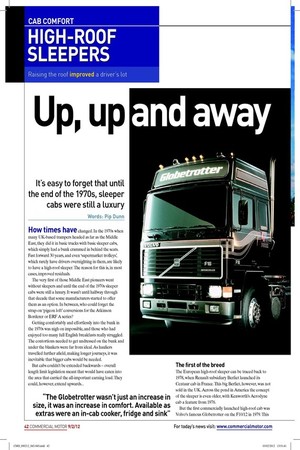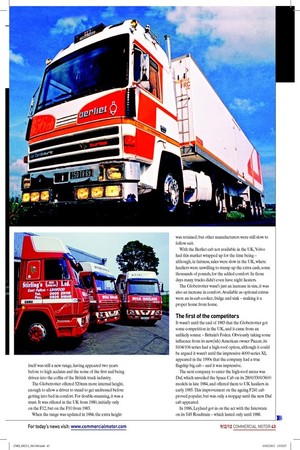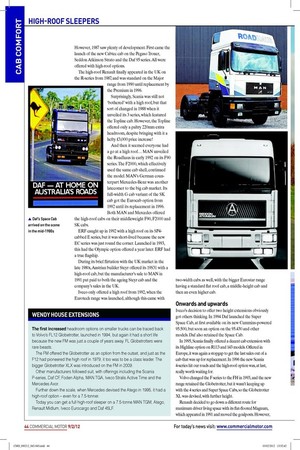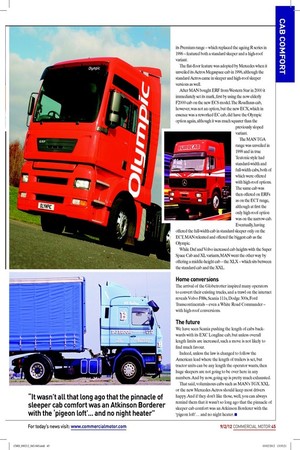Up, up and away
Page 34

Page 35

Page 36

Page 37

If you've noticed an error in this article please click here to report it so we can fix it.
HIGH-ROOF SLEEPERS
Raising the roof improved a driver’s lot
It’s easy to forget that until the end of the 1970s, sleeper cabs were still a luxury
Words: Pip Dunn How times have changed. In the 1970s when many UK-based trampers headed as far as the Middle East, they did it in basic trucks with basic sleeper cabs, which simply had a bunk crammed in behind the seats. Fast forward 30 years, and even ‘supermarket trolleys’, which rarely have drivers overnighting in them, are likely to have a high-roof sleeper. The reason for this is, in most cases, improved residuals.
The very irst of those Middle East pioneers went without sleepers and until the end of the 1970s sleeper cabs were still a luxury. It wasn’t until halfway through that decade that some manufacturers started to offer them as an option. In between, who could forget the strap-on ‘pigeon loft’ conversions for the Atkinson Borderer or ERF A series?
Getting comfortably and effortlessly into the bunk in the 1970s was nigh on impossible, and those who had enjoyed too many full English breakfasts really struggled. The contortions needed to get undressed on the bunk and under the blankets were far from ideal. As hauliers travelled further aield, making longer journeys, it was inevitable that bigger cabs would be needed.
But cabs couldn’t be extended backwards – overall length limit legislation meant that would have eaten into the area that carried the all-important earning load. They could, however, extend upwards...
The first of the breed
The European high-roof sleeper can be traced back to 1978, when Renault subsidiary Berliet launched its Centaur cab in France. This big Berliet, however, was not sold in the UK. Across the pond in America the concept of the sleeper is even older, with Kenworth’s Aerodyne cab a feature from 1976.
But the irst commercially launched high-roof cab was Volvo’s famous Globetrotter on the F10/12 in 1979. This itself was still a new range, having appeared two years before to high acclaim and the noise of the irst nail being driven into the cofin of the British truck industry.
The Globetrotter offered 520mm more internal height, enough to allow a driver to stand to get undressed before getting into bed in comfort. For double-manning, it was a must. It was offered in the UK from 1980, initially only on the F12, but on the F10 from 1983.
When the range was updated in 1984, the extra height was retained, but other manufacturers were still slow to follow suit.
With the Berliet cab not available in the UK, Volvo had this market wrapped up for the time being – although, in fairness, sales were slow in the UK, where hauliers were unwilling to stump up the extra cash, some thousands of pounds, for the added comfort. In those days many trucks didn’t even have night heaters.
The Globetrotter wasn’t just an increase in size, it was also an increase in comfort. Available as optional extras were an in-cab cooker, fridge and sink – making it a proper home from home.
The first of the competitors
It wasn’t until the end of 1983 that the Globetrotter got some competition in the UK, and it came from an unlikely source – Britain’s Foden. Obviously taking some inluence from its new(ish) American owner Paccar, its S104/106 series had a high-roof option, although it could be argued it wasn’t until the impressive 4000 series XL appeared in the 1990s that the company had a true lagship big cab – and it was impressive.
The next company to enter the high-roof arena was Daf, which unveiled the Space Cab on its 2800/3300/3600 models in late 1984, and offered them to UK hauliers in early 1985. This improvement on the ageing F241 cab proved popular, but was only a stopgap until the new Daf cab appeared.
In 1986, Leyland got in on the act with the Interstate on its T45 Roadtrain – which lasted only until 1988. However, 1987 saw plenty of development. First came the launch of the new Cabtec cab on the Pegaso Troner, Seddon Atkinson Strato and the Daf 95 series. All were offered with high-roof options.
The high-roof Renault inally appeared in the UK on the R-series from 1987, and was standard on the Major range from 1990 until replacement by the Premium in 1996.
Surprisingly, Scania was still not ‘bothered’ with a high roof, but that sort of changed in 1988 when it unveiled its 3 series, which featured the Topline cab. However, the Topline offered only a paltry 220mm extra headroom, despite bringing with it a hefty £3,000 price increase!
And then it seemed everyone had a go at a high roof... MAN unveiled the Roadhaus in early 1992 on its F90 series. The F2000, which effectively used the same cab shell, continued the model. MAN’s German counterpart Mercedes-Benz was another latecomer to the big cab market. Its full-width G cab variant of the SK cab got the Eurocab option from 1992 until its replacement in 1996. Both MAN and Mercedes offered the high-roof cabs on their middleweight F90, F2000 and SK cabs.
ERF caught up in 1992 with a high roof on its SP4cabbed E series, but it was short-lived because the new EC series was just round the corner. Launched in 1993, this had the Olympic option offered a year later. ERF had a true lagship.
During its brief lirtation with the UK market in the late 1980s, Austrian builder Steyr offered its 19S31 with a high-roof cab, but the manufacturer’s sale to MAN in 1991 put paid to both the ageing Steyr cab and the company’s sales in the UK.
Iveco only offered a high roof from 1992, when the Eurotech range was launched, although this came with two-width cabs as well, with the bigger Eurostar range having a standard lat roof cab, a middle-height cab and then an even higher cab.
Onwards and upwards
Iveco’s decision to offer two height extensions obviously got others thinking. In 1994 Daf launched the Super Space Cab, at irst available on its new Cummins-powered 95.500, but soon an option on the 95.430 and other models. Daf also retained the Space Cab.
In 1995, Scania inally offered a decent cab extension with its Highline option on R113 and 143 models. Offered in Europe, it was again a stopgap to get the last sales out of a cab that was up for replacement. In 1996 the new Scania 4-series hit our roads and the high-roof option was, at last, really worth waiting for.
Volvo changed the F series to the FH in 1993, and the new range retained the Globetrotter, but it wasn’t keeping up with the 4 series and Super Space Cabs, so the Globetrotter XL was devised, with further height.
Renault decided to go down a different route for maximum driver living space with its lat-loored Magnum, which appeared in 1991 and moved the goalposts. However, its Premium range – which replaced the ageing R series in 1996 – featured both a standard sleeper and a high-roof variant.
The lat-loor feature was adopted by Mercedes when it unveiled its Actros Megaspace cab in 1996, although the standard Actros came in sleeper and high-roof sleeper versions as well.
After MAN bought ERF from Western Star in 2000 it immediately set its mark, irst by using the now elderly F2000 cab on the new ECS model. The Roadhaus cab, however, was not an option, but the new ECX, which in essence was a reworked EC cab, did have the Olympic option again, although it was much squarer than the previously sloped variant.
The MAN TGA range was unveiled in 1999 and in true Teutonic style had standard-width and full-width cabs, both of which were offered with high-roof options. The same cab was then offered on ERFs as on the ECT range, although at irst the only high-roof option was on the narrow cab. Eventually, having offered the full-width cab in standard sleeper only on the ECT, MAN relented and offered the biggest cab as the Olympic.
While Daf and Volvo increased cab heights with the Super Space Cab and XL variants, MAN went the other way by offering a middle-height cab – the XLX – which sits between the standard cab and the XXL.
Home conversions
The arrival of the Globetrotter inspired many operators to convert their existing trucks, and a trawl on the internet reveals Volvo F88s, Scania 111s, Dodge 300s, Ford Transcontinentals – even a White Road Commander – with high-roof conversions.
The future
We have seen Scania pushing the length of cabs backwards with its EXC Longline cab, but unless overall length limits are increased, such a move is not likely to ind much favour.
Indeed, unless the law is changed to follow the American lead where the length of trailers is set, but tractor units can be any length the operator wants, then huge sleepers are not going to be over here in any numbers. And by now, going up is pretty much exhausted.
That said, voluminous cabs such as MAN’s TGX XXL or the new Mercedes Actros should keep most drivers happy. And if they don’t like those, well, you can always remind them that it wasn’t so long ago that the pinnacle of sleeper cab comfort was an Atkinson Borderer with the ‘pigeon loft’... and no night heater. ■
WENDY HOUSE EXTENSIONS
The first increased headroom options on smaller trucks can be traced back to Volvo’s FL12 Globetrotter, launched in 1994, but again it had a short life because the new FM was just a couple of years away. FL Globetrotters were rare beasts.
The FM offered the Globetrotter as an option from the outset, and just as the F12 had pioneered the high roof in 1979, it too was to be a class leader. The bigger Globetrotter XLX was introduced on the FM in 2009.
Other manufacturers followed suit, with offerings including the Scania P-series, Daf CF, Foden Alpha, MAN TGA, Iveco Stralis Active Time and the Mercedes Axor.
Further down the scale, when Mercedes devised the Atego in 1995, it had a high-roof option – even for a 7.5-tonner.
Today you can get a full high-roof sleeper on a 7.5-tonne MAN TGM, Atego, Renault Midlum, Iveco Eurocargo and Daf 45LF.











































